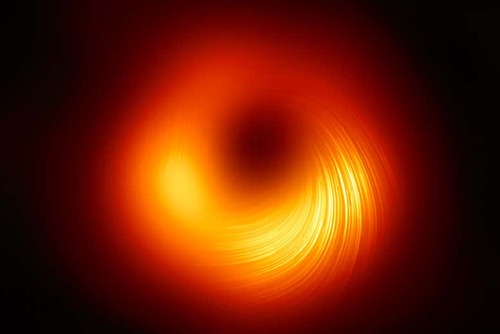


Ein Blick auf das supermassereiche Schwarze Loch M87 in polarisiertem Licht
EHT Collaboration / ESO
Das erste Bild des Schattens eines Schwarzen Lochs wurde noch interessanter. Die Zusammenarbeit mit Event Horizon Telescope (EHT) veröffentlichte 2019 das erste direkte Bild eines Schwarzen Lochs, und obwohl das Bild allein beeindruckend war, war es nicht das wissenschaftliche Smorgasbord, auf das einige gehofft hatten. Jetzt haben Forscher dem Bild polarisiertes Licht hinzugefügt, um eine Vorstellung davon zu bekommen, wie Magnetfelder um ein supermassereiches Schwarzes Loch mächtige Materiestrahlen erzeugen.
"Es gab nicht viele Informationen über die tatsächliche Physik des Gases um das Schwarze Loch", sagt Sara Issaoun, ein EHT-Teammitglied an der Radboud University in den Niederlanden. "Wenn wir es in polarisiertem Licht betrachten, erhalten wir Informationen über das Magnetfeld des Schwarzen Lochs."
The EHT uses a network of eight telescopes around the world to turn Earth into one giant radio telescope, which enabled an unprecedented view of the supermassive black hole at the centre of the M87 galaxy, 55 million light years away. The light that the EHT captures is emitted by electrons as they accelerate along magnetic fields, and the polarisation of the light depends on the direction of the magnetic field.
Using measurements of the polarised light near the M87 black hole, the EHT team found that the magnetic field’s strength is between 1 and 30 gauss. This is up to about 50 times the strength of Earth’s magnetic field as measured at the planet’s poles, where it is strongest.
“The polarised light has these curved swoops like a spiral,” says Issaoun. “This tells us that the magnetic field around the black hole is ordered, and this is really important because only an ordered magnetic field can launch jets – a scrambled magnetic field cannot do that.”
Some black holes, including the one in M87, spew enormous jets of matter, but how exactly they do so has long been a mystery. Researchers think the jets are launched and shaped by magnetic fields, but the evidence is limited.
Read more: Everything you need to know about the first black hole image
“This jet process is totally amazing – something the size of our solar system can shoot out a jet that pierces through entire galaxies and even galaxy neighborhoods,” says Issaoun. “Now we’re really seeing the magnetic field close to the black hole for the first time, and that’s connecting it to the jet, which is the most powerful process in the universe.”
Measuring this black hole’s magnetic field with polarised light allowed the researchers to significantly cut down on the number of possibilities for how the black hole and its jet work. They compared the observations with simulations of 120 different theoretical models, and only 15 of the models fit what we actually see.
It’s not yet clear whether the possibilities are similarly narrowed for all supermassive black holes or if it is specific to this one in particular. “A lot of what we need to do in the next few years is to figure out what lessons we can take from this to other sources as well,” says Andrew Chael, an EHT team member at Princeton University.
So far, it looks like all black holes with strong jets probably behave like the one in M87, he says. Adding just a few more telescopes to the EHT array – which the researchers already plan to do – could help nail down exactly how the black hole is launching its jet.
